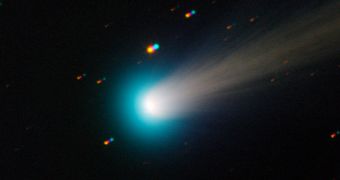As Comet ISON approaches its perihelion this November, telescopes around the world are trained on its trajectory. Astronomers are curious to see whether this object, also known as Comet C/2012 S1, will be able to survive its close encounter with the Sun.
Comet ISON will reach its perihelion – its point of closest approach to the Sun – on November 28. At that time, the object will be just 1.2 million (754,600 miles) kilometers away from the solar surface, and may easily be destroyed altogether, experts say.
This new image of the comet was snapped using the TRAnsiting Planets and PlanetesImals Small Telescope (TRAPPIST) instrument at the European Southern Observatory's (ESO) La Silla installation, in the Chilean Andes. TRAPPIST has been observing ISON for about a month before snapping this image, on November 15.
The photo was put together from multiple images collected by TRAPPIST on Friday. Astronomers used blue, green, red and near-infrared filters on the telescope, and took 30-second images of the comet. The data were then over-imposed to create this view.

 14 DAY TRIAL //
14 DAY TRIAL //